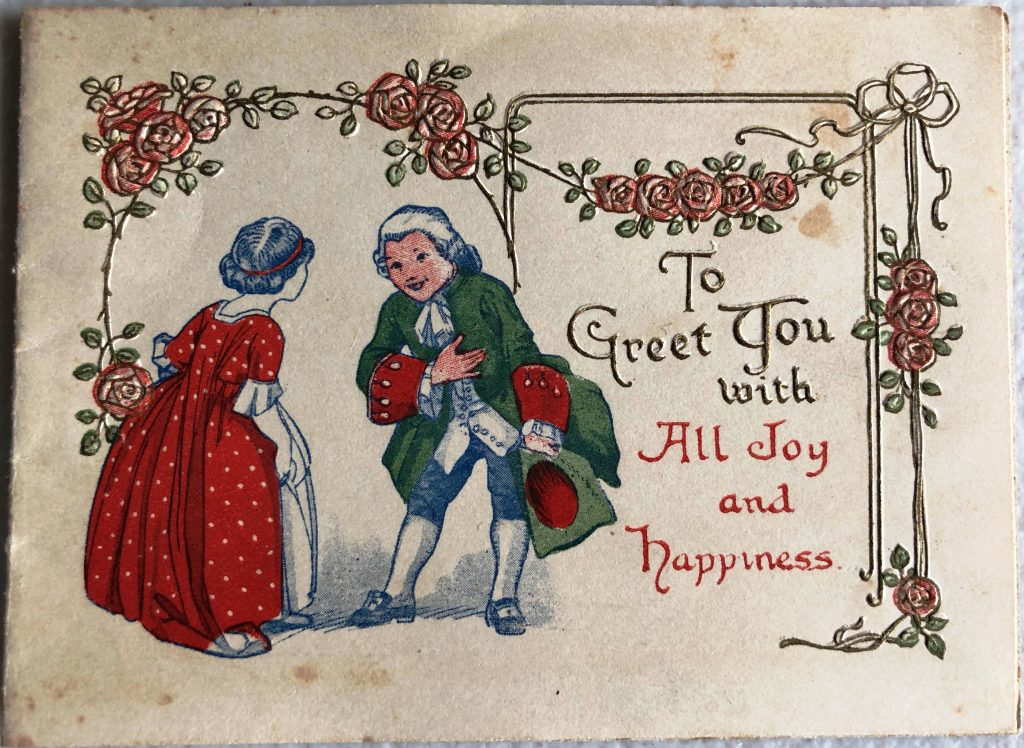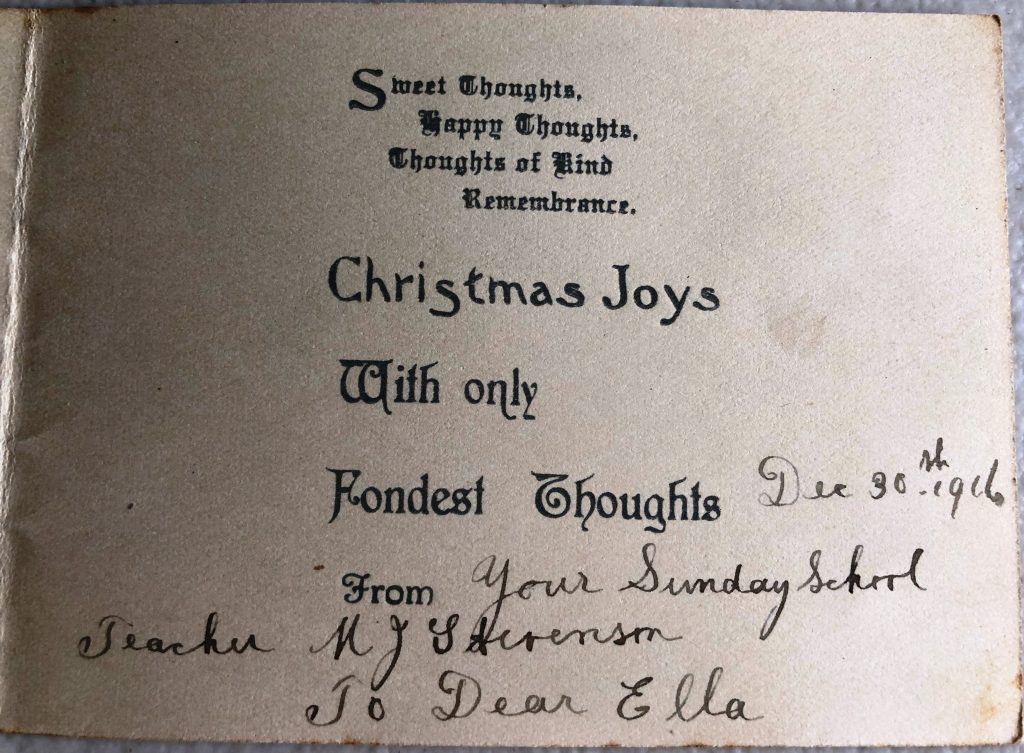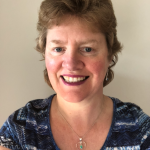BOHO and BOHO EAST FREE METHODIST CHURCHES
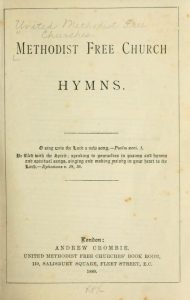 The United Methodist Free Church was active in Australia from 1857 to 1902. One of the most popular beliefs of the organisation, and the reason the denomination was called “Free Methodists”, was that each church location had the right and power to govern itself by its own local authority, without interference by the Annual Assembly and hierarchy.
The United Methodist Free Church was active in Australia from 1857 to 1902. One of the most popular beliefs of the organisation, and the reason the denomination was called “Free Methodists”, was that each church location had the right and power to govern itself by its own local authority, without interference by the Annual Assembly and hierarchy.
This was very different to how most of the other local mainstream churches of the day (Church of England, Presbyterian, Roman Catholic, etc) were organised.
The first Methodist minister Reverend Samuel Leigh, arrived in Australia in 1815 on board the passenger ship ‘Hebe’, with the first Methodist Church being erected in 1817 by John Lees on land donated by Lees in Castlereagh, Sydney.
At first the local school buildings at both Boho and Boho East were used as Free Methodist preaching places. Some of the pioneering families were Pascoe, James, Stevenson, Footter, and Mills, and in those days, there were 60 children in the Sunday School. Phillip James was one member of a pioneering family attending the Sunday School who later entered the Methodist Ministry. Both the Boho congregations became part of the Violet Town Circuit.
The first church at Boho was built by Mr John Pascoe, out of timber cut up in the hills by Mr Footter.
In 1886 the Violet Town circuit included eleven different preaching places – Violet Town, Baddaginnie, Karramonus, Moglenemby, Boho State School (Mr Hunter, head teacher), Boho East (Mr Pascoe, head teacher), Stony Creek, Upotipotpon, Marraweeney, Warrenbayne and Warrenbayne West. This entire area was covered by just three main preachers (Mr A Isaac and Mr L Walton of Violet Town, and Mr Martin Pascoe of Boho. Two other men were ‘on trial’ – Mr B Sessions and Mr P Williams. Four other men were listed as ‘helpers’ – Messrs Ward, Scott, Gibbons, and Gardiner.
One other important difference between the Free Methodist church and other denominations was that it permitted women to act as lay preachers. In August and September of 1886, the Violet Town circuit was looking forward to Miss Gilbert conducting evangelistic services.
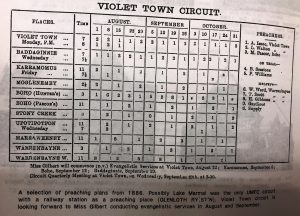
Methodist VT circuit 1886 preaching plan
In November 1890 great preparations were underway at Boho East, to celebrate the United Methodists anniversary on the coming 30th of the month. The local Euroa Advertiser newspaper Boho correspondent commented wryly, that the night will be a great success unless of course, the night turns out to be wet. The program was to include dialogues, recitations, and several select songs by the choir.
In 1896 a vote was taken, Victoria wide, on whether to unite the five different Methodist streams – Wesleyan Methodists, Primitive Methodists, Bible Christians, Methodist New Connexion and the United Free Methodists. In the Violet Town circuit, 80 members aged over 21 years voted. 74 voted for union, two were against, and four remained neutral.
The vote was overwhelmingly to unite, so local churches then had to surrender their own individual doctrinal statements. In theory this meant they would now forego the ability of lay members to do anything a minister could do (for example, communion). They also found themselves with greater ministerial control and a more rigid liturgical service. Perhaps where greater control of churches was more prevalent, such as the larger city churches, more control was maintained, but largely in the country, not much actually changed in practise.
Consequently, after union in 1902, the new church name was now the Methodist Church of Australasia.
In 1898 the church at Boho East was moved to its new location in Boho. It was moved there by Messrs Welsh and Wilson. The Boho Methodists were very active in their charity work and fundraising, and in 1899 had presented Rev Davey, at the parsonage in Violet Town with 1 pound 7 shillings for the Ovens Benevolent Asylum. The following year the congregation was again donating money this time to the Wangaratta District Hospital.
The young people throughout the circuit were very active in study groups, Methodist Girls Comrades, Order of Knights and the Christian Endeavour Society. The Boho church had a very active Young Christian Endeavour Society and in 1915 a group of twelve members were photographed in front of the church. The group included Mr Stevenson Charlie White, Seth Stevenson, Joe Strickland, Lily Stow, Christina White, Amy White, Maggie Stevenson, Rosie Balwin, Ralph and Barbara Stevenson. (pictured below).
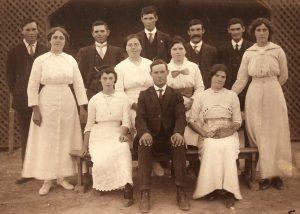
The Women’s Auxiliary for Overseas Mission held American tea days to raise money, especially from the 1880’s through to the end of the wars. Sunday School anniversaries were also held, and people came from near and far to take part, celebrate and watch the children receive book prizes.
The annual picnics were well attended, such as the combined Sunday School and Band of Hope event in April 1900. In the afternoon the large number of people indulged in outdoor games of various kinds, and in the evening a grand concert was held in the packed church. The newly appointed minister the Rev T Riding gave an address on the “curse, cause and cure of intemperance”, and it was well received and described as humorous, thoughtful and impressive. The concert included band items, several items on the autoharp by the Welsh brothers, humorous dialogue, vocal performances by Miss Williams and Mr Derx, recitations by Miss Fields and Miss Cook, and poems. A collection was taken up for the Sunday School.
In 1901 Violet Town had three chapels, four preaching places, five local preachers, one class leaders, 87 members, and an attendance of 200 people. The three local Sabbath (Sunday) Schools had an average attendance of 76.
- 1916 Christmas card from Boho Methodist Church Sunday School teacher M Stevenson to Ella Jackson
In 1914 the Spectator and Methodist Chronicle newspaper reported that the quarterly meeting held at Violet Town was presided over by the Rev J Edwards, and the financial statement showed a small deficiency. An excellent report was given regarding the Sunday schools, and the meeting would be losing an energetic worker, Mr James Welsh of Boho. The Boho folk provided an excellent tea on closing the meeting.
Every Methodist circuit printed Quarterly Plans and News for members, advising them of the upcoming three monthly preaching plans and local news. Included in these newsletters were all sorts of local articles, such as births (rejoicings), deaths (the heavenly call) and marriages, pastoral letters from the local preacher, coming events, thank offering details, Sunday school news, overseas mission news, and preaching plans. The balance sheet including income, expenditure and money paid out to home and overseas missions was also included. Expenses detailed items such as stipend, travelling allowances, postage, plans, fire insurance, and the printing of mission leaflets. Donations for specific events and causes were also detailed such as local church anniversaries, West Australia Mission, and the Memorial 7 Babies Homes.
They say Methodism was born in song. Charles Wesley wrote the first hymns of the Evangelical revival during 1738, when he and his brother were ‘filled with the Spirit’, and from that time onwards the Methodists have never ceased to sing. For half a century hymns poured continually from his pen on almost every subject within the compass of Christianity. Many of the local school teachers were members of the Boho Methodist church, and sometimes were also in the choir, or playing the harmonium.
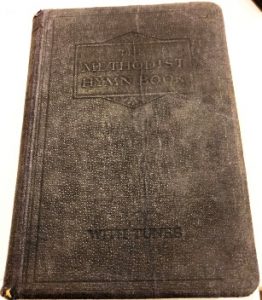
Methodist Hymn Book
Hymn books for use in the United Methodist Free churches were issued in 1860, 1889 and the latest was printed in London in 1933 (pictured) and are still in use in some traditional Methodist churches today.
A book was also specially produced for use with the younger members of the congregation at Sabbath (Sunday) School.
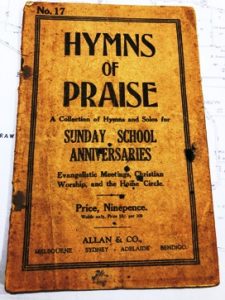
Methodist Sunday School Hymns of Praise book
The children of the Boho Free Methodist church sang from a book entitled ‘The School Hymn Book of the Methodist Church’, which informed them that this special edition had been prepared for use in the Commonwealth of Australia. It contained all the hymns in the English edition, with a special supplement authorised by the General Conference of the Methodist Church in Australasia. It was hoped that this particular book would be adopted by day schools, youth clubs and Sunday Schools across Australia.
Weddings, Funerals and Celebrations
Over the years local residents used the church for weddings, baptisms and funerals, conducted by the local circuit minister. In July 1900 Mr George Croxford and Miss Lillie Williams were married.
In March 1913 the wedding was held of Mr and Mrs Alfred Johnson, conducted by Rev Henry Wallace.
In January 1914, a large crowd gathered to farewell local minister and his wife Mr & Mrs Wallace. They had served at Boho for seven years, and their approaching departure was keenly felt by all. The couple were presented with a silver tray, and it was noted that Mr Wallace had secured the removal of the school to its present excellent site, helped establish the rifle club and its splendid range of targets, helped in the organisation of the rural fire brigade, and was instrumental in the formation of the choir.
Mr Wallace responded by saying how kind the people of Boho had been to himself and his wife, and how delighted he was by the lack of hoodlumism in the area, and that they had a fine class of young people amongst them. Mr Wallace was off to Warnambool with his family. Other people attending the farewell included Mr James Welsh, Mrs G White, Miss MacPherson, S Kelly, J Baldwin, J Edwards, and Captain Llewelyn of the Rifle Club.
In 1915 the Rev E Brown of South Wangaratta was conducting fortnightly services at Boho and were described as ‘promising well for the future’. Confirmation classes were also being conducted to prepare a number of candidates.
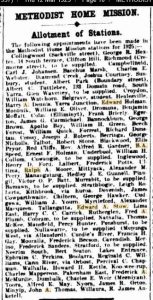
Edward A Stow Methodist Home Mission appt 1925 Lima East
Church attendance was up during the war, and in August 1915 the congregation was treated to a special sermon on “The Triumphant Spirit of Christendom in the World’s great war” by the Rev D A McEachern, followed by the celebration of Holy Communion.
In 1917 a memorial service was held for the late Private Joseph H Stevenson of Boho, conducted by the Rev T Roberts. At the conclusion of the service the Dead March was played. In October 1923 Mr George Hammond, a and Miss Emma Ruby White were married in the church. Emma was the granddaughter of Boho pioneer Richard White.
In 1918 the annual picnic was held at Boho. A concert was in the church in the evening to help pay for the land on to which the church has been removed.
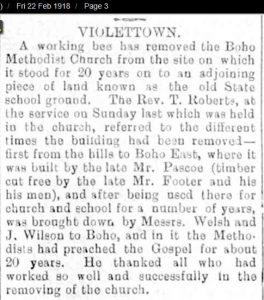
Boho Methodist church removed to school site 1918 Benalla Standard
Changing Locations
The early pioneers were to be thanked for their vision in providing the community with the church building. Mr Footter and his men provided the timber, and the first original church was built by Mr John Pascoe in 1886, on the saddle of a hill overlooking Boho West and East. Several families in the timber trade used the building here for about 11 years. On their removal from the district in 1898, the church was taken down by Messrs Welsh and Wilson and carted down to Boho and erected on Mr Crocker’s property. It was used as a church and school and in it the Methodists had preached the gospel for over 20 years.
In 1918 a working bee was held to move the church building again. It had stood on this site, for over 20 years, on an adjoining piece of land known as the old State School ground. Among those who worked willingly for several weeks to prepare the building for its move this time were – Messrs Rollinson, Llewellyn, George White, Mackrell, Shaw, Field, Backland, Stevenson, Footter, Mitchell, Hill, Eyres, Alf Johnston and R Sexton.
In 1948, the Boho church was removed and reconstructed once again. This time it was moved to a block of land given by Mrs F Welsh, at the corner of Boho Church and Smith’s roads. The church was said to be in good condition, despite its previous 60 years of continual use.
A service, led by the Violet Town Circuit minister Rev T Collis, was held in February to reopen and rededicate the church, with representatives of church, state and shire attending the Saturday afternoon affair.
After a great deal of singing, a sermon on, the readings of telegrams and greetings by well-wishers, the attenders were treated to a lovely afternoon tea prepared by the local ladies of the congregation. The afternoon was concluded by the singing of the national anthem “God Save the Queen”.
In 1953, the circuit stewards were local Boho members Mr Douglas Welsh and Mr H Kubeil. The Boho Ladies Guild was meeting monthly, raising much need funds for both the church, and the overseas mission ‘to help distribute the Bread of Life to our sisters and brothers overseas’. The ladies of the parish were regularly thanked for ‘beautifying God’s Houses with flowers’. The morning service was held at 10am, twice and sometimes three times a month, and was conducted by Pastor A Baker.
The church was an import part of the fabric of the community, conducting family picnics and afternoon teas, supporting members, celebrating birthdays, and providing much needed funds for local and overseas charities.
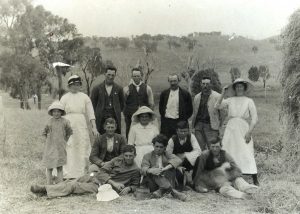
1915 Boho church outing
Members of the church were active in helping the pastor and his wife survive on their small allowance. Mr Cyril Welsh was thanked for carting a large truckload of firewood to the parsonage, and Mr Alex Welsh was also thanked for the use of his saw bench and for sawing the wood into manageable foot length blocks.
The Boho people also did most of their own upkeep and repairs on their church buildings, including building on a porch and painting the entire church.
The one remaining Boho Methodist church was very active until numbers declined during late 1950s, when it closed. Most of the congregation then worshipped at either Boho South in a new building, or at Violet Town.
In 1977, most of the Methodist churches joined with the congregations of the Presbyterian Church of Australia and the Congregational Union of Australia to form the now current, Uniting Church of Australia.
List of Itinerant Preachers in the Violet Town Circuit including Boho –
1879 W Dixon, 1 year
1880 F Snell, 1 year
1882 J Richards, 3 years
1885 Abraham Isaac, 2 years
1885 A Isaac, 2 years
1886 L Walton, 1 year
1886 Levi Watton, 1 year
1887 Thomas Payne, 1 year
1888 W Chapman, 2 years
1890 Benjamin Goldsworth, 3 years
1893 R Reed, 1 year
1894 Richard Whitford, 1 year
1895 Herbert Hill, 2 years
1897 Walter Davey, 3 years
1900 Thomas Riding, 2 years
1905 R Richardson
1906 J Leslie
1909 A Ditterick
1913 Rev J W Edwards
1916 T Roberts
1920 Rev Connan
1921 Rev Allsop
1926 R Williams
1927 K Malseid
1932 A Newnham
1939 H Mitchell
1941 R Hopper
1945 A Yourn
1947 T Collis
1953 Pastor A Baker
Sources
“Captives of Freedom” Free Methodism in Australia 1837-1901, Travis Haig and Aubrey Quick
“Jottings Baddaginnie” Centenary of the Methodist Church 1882-1982
Benalla Standard Newspaper, Friday 22 February 1918, page 3
Benalla Ensign Newspaper, Friday 27 February 1948, page 3
Ovens and Murray Advertiser, Sat 28 October 1899, page 4
Leader Newspaper, Melbourne, Sat 7 July 1900, page 38
Methodism in Australia A History, Glen O’Brien and Hilary Carey, Ashgate Publishing, Surrey, 2015
Victorian Methodist Archives – https://www.victas.uca.org.au/UCA%20Resources/archive/Pages/home.aspx
Authors Own Collection
Violet Town United Free Methodist Preaching circuit 1888
Violet Town Methodist Church of Australia Quarterly Plan and News 1953
The Methodist Hymn Book for use in Australasia and New Zealand, Novello and Co Ltd Printers, London, 1933
The School Hymn Book of the Methodist Church, Methodist Youth Department, London,1950
The ‘Welcome’ Hymns and Tunes for Sunday School Anniversaries and Church Services, Harston, Partridge & Co, 1930
Hymns of Praise for Sunday School Anniversaries, Evangelistic meetings, Christian Worship and Home Circle, Alans, Melbourne.

